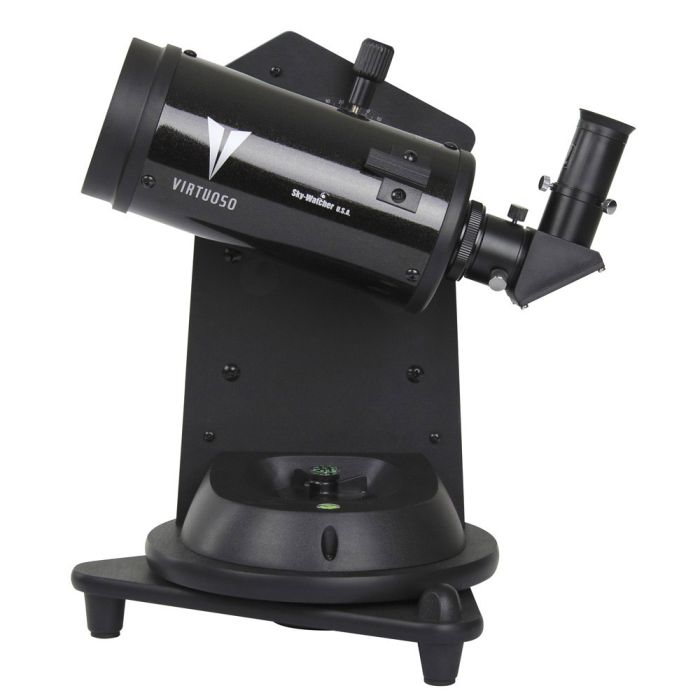The Optical Tube
The Skywatcher Heritage 90P Virtuoso Mak’s optical tube is the same as Sky-Watcher’s SkyMax 90, which is itself the same as the Celestron C90 optical tube and many of the other 90mm Maksutov-Cassegrains from “competing” brands. The Heritage 90P Virtuoso Mak is a 90mm (3.5”) f/13.9 Maksutov-Cassegrain telescope with a 1250mm focal length. Maksutov-Cassegrains are easy to make with tight tolerances because the secondary mirror is just an aluminized part of the front meniscus corrector lens. Their “folded” light path produces a very long focal length in a stubby optical tube. As a result, they are typically very sharp on targets such as the moon, planets, and double stars, though the 90mm aperture and long focal length limit what you can see of deep-sky objects. Maksutov-Cassegrains don’t need to be collimated due to the integrated secondary mirror, and focusing is accomplished by turning a knob at the back end of the telescope to slide the primary mirror back and forth, adjusting the position of the focal plane but not your eyepieces/accessories attached to the back end.

Like most commercial Maksutov-Cassegrains, the Heritage 90P Virtuoso Mak has a 1.25″ screw-on visual back with proprietary threads to attach it to the telescope. The visual back has T-threads exposed at the back to easily attach a DSLR camera if you wish; other accessories, such as a star diagonal or CMOS planetary camera, insert into the visual back.
The Heritage 90P Virtuoso Mak has a Vixen-style dovetail bar attached to the side of the tube for easy attachment to and use on the provided mount or with almost any astronomical mount; you can also attach the tube directly to a photo tripod head with the ¼ 20 threads embedded in the dovetail plate.
Accessories
The Sky-Watcher Heritage 90P Virtuoso Mak telescope comes with a standard 1.25” prism diagonal, the same as is supplied with many Celestron telescopes. It’s high-quality and uses a multi-coated glass prism for around 98% transmission, as good as many mirror diagonals. You also get two 1.25” “Super” Konig eyepieces, which have longer eye relief than a typical Plossl or Kellner and a 55-degree apparent field of view—a 25mm for 50x and a 10mm for 125x. These may be the only eyepieces you need; they have plastic bodies, but the optics are multi-coated glass lenses, and they are plenty crisp at the Virtuoso 90’s focal ratio of f/14, right out to the edges of the field of view.
The Heritage 90P Virtuoso Mak is somewhat unique in its inclusion of a white-light film solar filter with the telescope. The filter is completely safe and allows for easy viewing of sunspots on the Sun’s surface. It does stop down the aperture of the telescope somewhat, but this isn’t a huge concern.
For a finder, the Heritage 90P Virtuoso Mak uses a 5×24 finder scope exactly like the kind used on many “department store” telescopes. The body and optics are entirely plastic; the field of view is narrow, and the image is terribly dim. It’s good enough to function with the Virtuoso 90 and is easy to replace with a red dot if you wish; the bracket at least tends to hold alignment with the telescope pretty well, which is more than can often be expected of these finders. You also get a solar finder that installs in place of the 5×24 for solar viewing.
The Virtuoso Mount
The Sky-Watcher Heritage 90P Virtuoso Mak mount has little in common with the mount supplied with the similarly named Virtuoso GTi telescopes. It is a tabletop alt-azimuth mount made out of particle board and plastic, somewhat like a tabletop Dobsonian, with a Vixen-style dovetail saddle to interchange optical tubes. A bracket to attach a camera or smartphone directly to the mount is also included with the Virtuoso kit. You can run the mount with AA batteries placed in a compartment in the side or with an external power source.
By default, this simple alt-azimuth mount will track the sky like an equatorial mount if you level it, point it north with the telescope aimed at the horizon, and turn the mount on. There are buttons on the side of the mount for pointing, or you can unlock the clutches and aim it by hand. Plugging in a Sky-Watcher SynScan WiFi adapter or hand controller will instantly convert the telescope/mount to a fully GoTo unit with no other modifications, and you can unlock the clutches and aim the telescope manually without disrupting the alignment of the GoTo system. Why a WiFi adapter isn’t just a default part of the telescope like the Virtuoso GTi is a mystery.
The Virtuoso mount also has some features for photography and videography, such as automatic panning and shutter release controls, if you have any use for those. You either set the mount atop a steady tabletop surface. If you want a tripod, you can screw the mount to any tripod with a ⅜” stud or build your own stand like the ones commonly built for tabletop Dobsonian telescopes.
Should I buy a Used Sky-Watcher Heritage 90P Virtuoso Mak?
A used Sky-Watcher Virtuoso 90 should be a great telescope. The electronics in the mount are fairly simple and easy to test. The optical tube should, of course, be free of any corrosion or cracks in the optics, which are fairly easy to spot. The particle board in the mount is probably the most fragile aspect of the Virtuoso 90, and any damage to it will prevent the mount from smoothly moving or tracking, as well as GoTo functionality if you decide to upgrade.
One caveat: we wouldn’t recommend you try out a used solar filter, even if it’s been stored carefully; your eyeballs are not worth saving a few tens of dollars.
Alternative Recommendations
The Virtuoso 90 is not nearly as big as some of the other telescopes in its price range, many of which are equally portable tabletop reflectors with short tubes.
Under £400
- The Sky-Watcher Heritage 150P offers significantly more aperture than the Virtuoso 90 – more than tripling the light gathering power and almost doubling resolution – with a collapsible tube for portability, two quality eyepieces included, a wide field thanks to it short 750mm focal length, and a simple tabletop Dobsonian mount.
- The Sky-Watcher Heritage 130P is much like the 150P but lower in price and slightly more compact. The 130P still is leaps and bounds better in viewing performance than the Virtuoso 90 thanks to its larger aperture.
- The Zhumell Z114 has a very wide field of view with its short 450mm focal length and a significant jump in light gathering ability over the Virtuoso 90, with a solid tube for simplicity. Like the other scopes listed here, it is a tabletop Dobsonian.
- The Zhumell Z100/Orion SkyScanner 100 offers a much wider field of view than the Virtuoso 90 with slightly better deep-sky views and equal planetary performance at a very low price. However, it doesn’t track of course, and dedicated planetary eyepieces are needed for high-power views.
- The SarBlue Mak60 with Dobsonian Mount is extremely lightweight and compact with the same sharp Maksutov-Cassegrain optical design as the Virtuoso 90. However, its pitiful aperture struggles even on the brightest targets.
£400-£600
- The Sky-Watcher Virtuoso GTi 150P is identical to the Heritage 150P but adds motorized tracking and GoTo with the same FreedomFind manual-aiming technology as the Virtuoso 90, as well as control via your smartphone/tablet.
- The Bresser Messier 6” f/8 Planetary Dobsonian has significantly more aperture than the Virtuoso 90 and features a 2” Crayford focuser allowing a similar field of view to 6” f/5 tabletop telescopes. However, it stands on the ground on its own and uses a solid tube, without the compromises of a tabletop mount or open-framed collapsible tube.
- The Celestron Astro-Fi 102 is a Maksutov-Cassegrain much like the Virtuoso 90 but features full GoTo controlled via your smartphone or tablet, a bit more aperture for greater light-collecting and resolving power, and a full-sized mount and tripod.
Aftermarket Accessory Recommendations
We highly recommend a dew shield for the Heritage 90P Virtuoso Mak, as with any catadioptric telescope, to minimise glare from nearby light sources entering the telescope, as well as to slow down frost or dew formation on the Virtuoso 90’s front corrector plate, and to safeguard against pollen, dirt, and dust. It might also be beneficial to acquire a few additional eyepieces to enhance your collection.
While the stock eyepiece and accessory kit is more than enough for the Virtuoso 90, you may wish to expand your collection a little further. A 32mm Plossl eyepiece for 39x magnification with the Virtuoso 90 provides a slightly wider field of view and lower magnification than the provided 25mm eyepiece, making it more suitable for viewing deep-sky objects, though there aren’t a whole lot of those to see with a 90mm Maksutov-Casasegrain. You also could add a 15mm redline or goldline wide-angle eyepiece (83x) to fit between the provided 25mm and 10mm eyepieces in magnification. Finally, while the provided 10mm eyepiece provides plenty of magnification for this relatively small scope, a 9mm redline/goldline (139x) is a bit sharper and more comfortable to use if you would like to spend the money.
What can you see?
The Virtuoso 90’s small aperture and long focal ratio limit the possibilities of viewing deep-sky objects. Even the most viewable galaxies are going to be smudges even under dark skies, with the possible exception of a barely-visible dust lane in the brightest galaxies such as M31 or M82. Globular star clusters and planetary nebulae are unresolved faint smudges. Open star clusters like M35 or M11 look pretty, provided you can fit them in the Virtuoso 90’s limited field of view or find them at all with the stock 5×24 finder. The brightest nebulae like Orion (M42) and the Lagoon (M8) show basic details and star clusters within, though they are not nearly as brilliant or detailed as in a larger instrument, especially if you observe from light-polluted skies. However, double stars are a delight with the Virtuoso 90 thanks to its sharp optics, lack of diffraction spikes or chromatic aberration, and motorized tracking. You can go after many thousands of these, often with contrasting colors, regardless of your sky conditions.
The Virtuoso 90 shines on Solar System objects. The Sun of course shows sunspots and its granular photosphere “surface” on a good day with the provided solar filter. You can see the phases of Mercury and Venus, as well as some dark markings and the polar ice caps on Mars. The Moon is jaw-dropping with thousands of observable details such as craters, mountain chains, and ridges. You can also see the colorful cloud belts and Great Red Spot on Jupiter, its four large moons, and the disks and shadows of the moons during transits under favorable seeing conditions. Saturn’s rings and the Cassini Division within them look razor-sharp, and you can also spot cloud belts on Saturn alongside a handful of faint moons. Uranus looks like a bloated teal-green “star,” while Neptune is hardly more than a pinpoint; a larger aperture is required to see their moons, resolve Neptune, or go after tiny and faint Pluto, which is well beyond the reach of a 90mm telescope.


